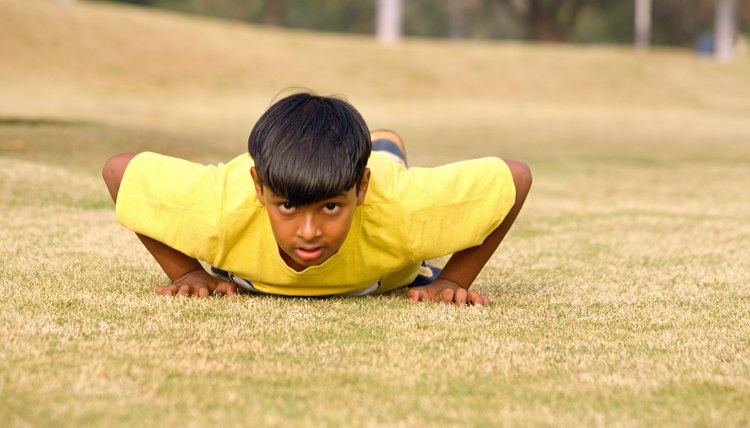How to Build Muscle for Kids

Building muscle during the childhood years is important for strength and endurance during daily activities and sports. It is also a good way to improve bone density and strengthen tendons and ligaments that help support your child's bones. A healthy diet and plenty of exercise are important components of muscle building. Don't confuse muscle building with powerlifting or bodybuilding, which are not recommended for children or teens because it may interfere with growth and development, according to the Kids Health website. Talk to your child's doctor about an appropriate muscle-building routine that aligns with his goals and health status.
Serve your child plenty of protein. This nutrient is the building block of muscles and is important for your child's muscular growth and development. Offer lean beef, chicken, fish, pork, beans, nuts or low-fat dairy foods at each meal. Children need 5 to 6 1/2 ounces of protein each day.
Feed your child foods from each food group. While protein is important for building muscle, eating a variety of foods from each food group promotes good overall health and helps your child meet her daily nutrient goals, which support muscle growth. Offer her 1 1/2 to 2 cups of fruit, 2 to 3 cups of vegetables, 3 to 4 ounces of grains and 3 cups of dairy each day, in addition to protein foods.
Encourage daily exercise. Any type of physical activity promotes healthy muscle development, including biking, swimming and dancing. Have your child get moving for at least 30 minutes per day throughout childhood.
Suggest strength training. Lifting weights is beneficial, in addition to regular exercise, for children who have reached puberty, around age 13. Before this, your child's body lacks the hormones needed to bulk up, and some doctors advise against using weights. With a pediatrician's approval, allow your older child to lift weights two to three times per week to strengthen and build larger muscles. Push-ups, planks, crunches, sit-ups and lunges are good strength training exercises that don't require weights.
Tips
Avoid letting your child use weights until he learns proper form and technique. This reduces the risk of injury and maximizes the muscle-building benefits. Hire a coach or personal trainer to instruct your child. Encourage your child to use weights with a pound load that allows him to do 8 to 15 repetitions per set. If this is difficult for him to complete, choose a smaller weight.
Warnings
Never allow children to use steroids or other performance-enhancing drugs. While some doctors might approve them for adult use, they are dangerous for children and pose a risk of mental and physical damage.
References
Writer Bio
Eliza Martinez has written for print and online publications. She covers a variety of topics, including parenting, nutrition, mental health, gardening, food and crafts. Martinez holds a master's degree in psychology.
